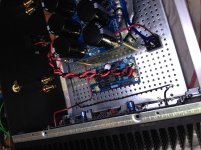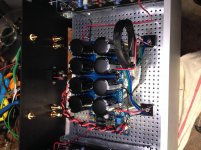My F4 is slowly coming together... PSU up on makeshift risers over 500VA transformer in 4U chassis, soft start and amp boards in place... Dry fitting wires before final dressing... More work to do. 🙂
Attachments
Last edited:
thanks!
I have a Coffman labs G1A pre-amp, but will likely be driving the F4 with my Bottlehead paramount 300B SET monoblocks... or at least that's the plan right now 🙂
b
I have a Coffman labs G1A pre-amp, but will likely be driving the F4 with my Bottlehead paramount 300B SET monoblocks... or at least that's the plan right now 🙂
b
Ooh! That's something I would like to try someday. The F4 really is invisible, it will let the full flavor of the 300B pass through. (And have damping factor and power...) 🙂
As the 300B amp is going to be designed around that plate load, yes.
But generally? No. Look at the Bottlehead Bee Pre. BeePre 300B Preamplifier Kit | Bottlehead
But generally? No. Look at the Bottlehead Bee Pre. BeePre 300B Preamplifier Kit | Bottlehead
6L6: To make good use of an SE tube amp driving the F4 couldn't you get a different OPT and load it properly to keep the SE in the sweet spot distortion-wise while raising the output to maybe swing 17 Vrms into the F4?
What I'm thinking is a typical OPT for SE might be, say 5k/8 ohm...but if you went to 5k/100 ohm, and then loaded the output with a 100 ohm resistor and connect to the F4 you would maintain the plate load and increase the voltage output. I'm not sure how to calculate the specs for the OPT.
Is it something like
5k/8 transformer is a .0016 impedance ratio
turns ratio would be the square root of that....so .04
if the turns ratio is equal to the gain ratio that would be .04 also
if we wanted to double the gain (turns ratio) to .08 we would then square that to get the new impedance ratio
so the transformer we would want would be 5k/32 and we would load with a 32 ohm resistor.
I'm likely way over simplifying this but is my thinking even close?
thanks
Phil
What I'm thinking is a typical OPT for SE might be, say 5k/8 ohm...but if you went to 5k/100 ohm, and then loaded the output with a 100 ohm resistor and connect to the F4 you would maintain the plate load and increase the voltage output. I'm not sure how to calculate the specs for the OPT.
Is it something like
5k/8 transformer is a .0016 impedance ratio
turns ratio would be the square root of that....so .04
if the turns ratio is equal to the gain ratio that would be .04 also
if we wanted to double the gain (turns ratio) to .08 we would then square that to get the new impedance ratio
so the transformer we would want would be 5k/32 and we would load with a 32 ohm resistor.
I'm likely way over simplifying this but is my thinking even close?
thanks
Phil
My un-educated understanding was that the SET was to be loaded with a 20-22R load out the outputs when connecting to the F4 inputs
Is this same as you are saying?
B
Is this same as you are saying?
B
My un-educated understanding was that the SET was to be loaded with a 20-22R load out the outputs when connecting to the F4 inputs
Is this same as you are saying?
B
Well, yes, that's one option but I think then you are limited to the low output typical with the SET, say just a few watts. What I'm thinking is that by using the proper OPT and driving the F4 you can get the wattage up much higher and keep the SET operating in a region with low distortion. Idea is that the SET is seeing the same load it would driving an 8 ohm speaker at 1 watt, but the OPT is putting out a higher voltage, into a smaller load and the F4 provides the current gain.
one thing is already having SET amp ( loading it with 2-3 times higher load then speaker) and boosting it with F4 ............. and another thing is using/making completely new preamp , for same purpose
one thing is already having SET amp ( loading it with 2-3 times higher load then speaker) and boosting it with F4 ............. and another thing is using/making completely new preamp , for same purpose
Yes, I don't already have an SET so would be possibly building just for this purpose. That's what makes me want to figure out if I can maximize the SET/F4 combo.
I'm in the former camp as Zen Mod describes it... Already have a lovely preamp and a pair 300b amps. I'm building the F4 for fun but still intend to keep my amps as is. Neat ideas though
B
B
Last edited:
I'm likely way over simplifying this but is my thinking even close?
You are totally in the ballpark. 😀
Long story made short - the 300B secondary is going to be loaded with the 47K resistor in the input of the F4, and that's a bit high for the transformer, hence the reason for a smaller, higher wattage resistor on the 300B output.
Look back a couple pages, Debra experimented with the loading on her SET amp and found something that worked very well.
Has anyone found it worthwhile placing some polyprops with good DF on the supply at the amp boards as the wires running from the power supply board is fairly long?
Tiny toroid. I dont think it can handle this amp. Whats the VA rating?
not quite the answer I was looking for🙁. It is a 300VA, its quite thick (higher) than it looks.
Fantastically clean build! Congratulations!
300VA is fine -- the factory FirstWatt amps use 300VA.
If you are going to add caps at the end of the wires, make them big, not little, as you are making another RC filter, and the amp will look to the closest caps for power if a big transient demands it. Adding some polys at the PSU board can't hurt, if you want to play with it.
300VA is fine -- the factory FirstWatt amps use 300VA.
If you are going to add caps at the end of the wires, make them big, not little, as you are making another RC filter, and the amp will look to the closest caps for power if a big transient demands it. Adding some polys at the PSU board can't hurt, if you want to play with it.
Fantastically clean build! Congratulations!
300VA is fine -- the factory FirstWatt amps use 300VA.
If you are going to add caps at the end of the wires, make them big, not little, as you are making another RC filter, and the amp will look to the closest caps for power if a big transient demands it. Adding some polys at the PSU board can't hurt, if you want to play with it.
Thank you for the informative answer 6L6. What do you suggest as 'big' I added 4x 4u7 polys one on each rail, is that ok?
- Home
- Amplifiers
- Pass Labs
- A guide to building the Pass F4 amplifier


